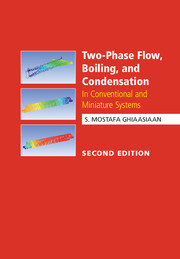Refine search
Actions for selected content:
5486 results in Thermal-fluids engineering
Chapter 5 - Combustion and Thermochemistry
-
- Book:
- Rocket Propulsion
- Published online:
- 21 March 2019
- Print publication:
- 07 February 2019, pp 134-176
-
- Chapter
- Export citation
Preface
-
- Book:
- Rocket Propulsion
- Published online:
- 21 March 2019
- Print publication:
- 07 February 2019, pp ix-xi
-
- Chapter
- Export citation
Frontmatter
-
- Book:
- Rocket Propulsion
- Published online:
- 21 March 2019
- Print publication:
- 07 February 2019, pp i-iv
-
- Chapter
- Export citation
Appendix
-
- Book:
- Rocket Propulsion
- Published online:
- 21 March 2019
- Print publication:
- 07 February 2019, pp 555-569
-
- Chapter
- Export citation
Chapter 4 - Rocket Nozzle Performance
-
- Book:
- Rocket Propulsion
- Published online:
- 21 March 2019
- Print publication:
- 07 February 2019, pp 81-133
-
- Chapter
- Export citation
Chapter 1 - Classification of Rocket Propulsion Systems and Historical Perspective
-
- Book:
- Rocket Propulsion
- Published online:
- 21 March 2019
- Print publication:
- 07 February 2019, pp 1-19
-
- Chapter
- Export citation
Chapter 9 - Liquid Rocket Propellants
-
- Book:
- Rocket Propulsion
- Published online:
- 21 March 2019
- Print publication:
- 07 February 2019, pp 348-400
-
- Chapter
- Export citation
Chapter 8 - Liquid Rocket Engines
-
- Book:
- Rocket Propulsion
- Published online:
- 21 March 2019
- Print publication:
- 07 February 2019, pp 282-347
-
- Chapter
- Export citation
Chapter 3 - Trajectory Analysis and Rocket Design
-
- Book:
- Rocket Propulsion
- Published online:
- 21 March 2019
- Print publication:
- 07 February 2019, pp 47-80
-
- Chapter
- Export citation

Two-Phase Flow, Boiling, and Condensation
- In Conventional and Miniature Systems
-
- Published online:
- 01 February 2019
- Print publication:
- 11 January 2017
-
- Textbook
- Export citation
Acknowledgements
-
- Book:
- Principles of Thermodynamics
- Published online:
- 14 December 2018
- Print publication:
- 03 January 2019, pp xv-xvi
-
- Chapter
- Export citation
9 - Matter and Electromagnetic Fields
- from Part IV - Exercises and Solutions
-
- Book:
- Principles of Thermodynamics
- Published online:
- 14 December 2018
- Print publication:
- 03 January 2019, pp 456-466
-
- Chapter
- Export citation
11 - Thermodynamics of Irreversible Processes
- from Part III - Continuous Media
-
- Book:
- Principles of Thermodynamics
- Published online:
- 14 December 2018
- Print publication:
- 03 January 2019, pp 308-360
-
- Chapter
- Export citation
6 - Phase Transitions
- from Part IV - Exercises and Solutions
-
- Book:
- Principles of Thermodynamics
- Published online:
- 14 December 2018
- Print publication:
- 03 January 2019, pp 405-419
-
- Chapter
- Export citation
5 - Calorimetry
- from Part IV - Exercises and Solutions
-
- Book:
- Principles of Thermodynamics
- Published online:
- 14 December 2018
- Print publication:
- 03 January 2019, pp 399-404
-
- Chapter
- Export citation
Contents
-
- Book:
- Principles of Thermodynamics
- Published online:
- 14 December 2018
- Print publication:
- 03 January 2019, pp v-xii
-
- Chapter
- Export citation
Frontmatter
-
- Book:
- Principles of Thermodynamics
- Published online:
- 14 December 2018
- Print publication:
- 03 January 2019, pp i-iv
-
- Chapter
- Export citation
9 - Matter and Electromagnetic Fields
- from Part III - Continuous Media
-
- Book:
- Principles of Thermodynamics
- Published online:
- 14 December 2018
- Print publication:
- 03 January 2019, pp 241-276
-
- Chapter
- Export citation
2 - Entropy and Second Law
- from Part IV - Exercises and Solutions
-
- Book:
- Principles of Thermodynamics
- Published online:
- 14 December 2018
- Print publication:
- 03 January 2019, pp 372-378
-
- Chapter
- Export citation
3 - Thermodynamics of Subsystems
- from Part I - Foundations
-
- Book:
- Principles of Thermodynamics
- Published online:
- 14 December 2018
- Print publication:
- 03 January 2019, pp 49-69
-
- Chapter
- Export citation
